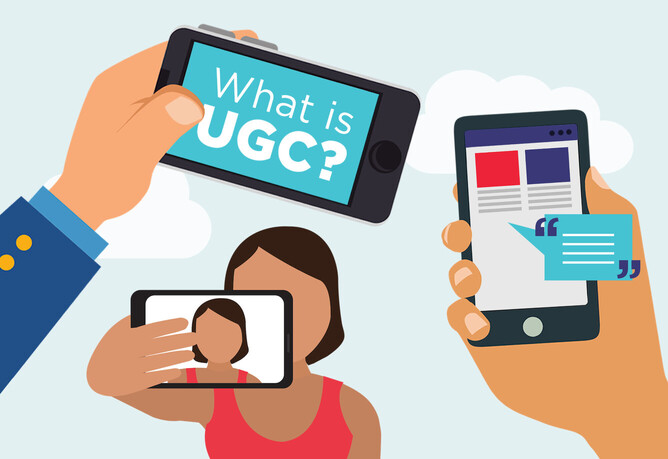For those of you who’ve never heard the acronym ‘UGC’ before, User Generated Content is any type of content created and published to social media by unpaid contributors, i.e. your followers.
UCG can include pictures, videos, testimonials, tweets, stories, blog posts, and pretty much anything else. Basically UGC is created when social media users advertently or inadvertently promote a brand via their own content, rather than the brand promoting itself.
To give you an idea of why UGC is so powerful, 86% of millennials say that user generated content is generally a good indicator of the quality of a brand or service (Bazaarvoice), and 65% of social media users between the ages of 18 and 24 consider information shared on social media when they make a purchasing decision (eMarketer).
WHY SHOULD YOU FOSTER & INCORPORATE UGC IN YOUR SOCIAL MEDIA STRATEGY?
We all know that over the years organic reach has declined significantly on Facebook, and across all social media platforms. A great way to combat this is customer advocacy. Enter the role of the ‘influencer’, the (often) paid (or at least reimbursed) source of user generated content.
The free version of this? Using loyal customers to promote your product or services for you.
It’s very possible for your marketing efforts to make a bigger, faster impact through UGC and sharing fostering UGC is not only a great way to create fresh, persuasive new content, it’s a sure-fire way to encourage continued customer loyalty.
Want more stats? Take ‘em. The Q2 2016 Sprout Social Index found that around 75% of consumers will share a positive experience with a brand. This is marketing GOLD. Consumers are also 70% more likely to make a purchase with a company after a good interaction. So if you’re sharing UGC, expect your conversion rates to soar in no time.
UGC is also a great way to increase engagement opportunities with your audience. Being mentioned or having content shared by a brand is always fun and exciting for consumers. There’s simply more person to person trust (and therefore persuasion) with UGC than there is when a brand (or marketing professional) ‘sells’ to a person. These days consumers are more aware of direct marketing techniques, and actively try to avoid making purchase decisions based on plain old advertising.
Cold-hard fact: UGC posts shared to social channels see a 28% higher engagement rate than standard brand posts (ComScore).
Want to see a great example of UGC done well? Mexico’s approach to user-generated content, is to show off its customers’ experiences. In return for this loyalty, customers often find themselves scoring free drinks or vouchers. This strategy is a great way to get more people sharing their love for Mexico with followers, super-charging brand awareness, and recommendations from real people.
MATCHING THE MOST EFFECTIVE CONTENT TO YOUR PLATFORMS, AND AUDIENCES:
To ensure user-generated content delivers the best return possible, it’s important to know which social networks your target audience frequent, and also where your potential advocates have the most influence.
- On Facebook, UGC video content and stories about your brand is highly effective.
- Twitter is good for recommendations in the form of text and image re-tweets. The New Zealand user base is relatively small, but not as limited as you might think.
- Instagram is often is the go-to for UGC, but it’s critical to know how to regram, and use Instagram Explore to find content gold. Being able to show off a customer using your product makes Instagram a great place for brands to get visual and connect with their audience.
- LinkedIn is a professional network, so UGC should be relevant to high level industry (and brand) and positioning. Think company culture, R&D, innovation - employee advocacy is the perfect fit for UCG on this platform!
SET SPECIFIC UGC GOALS
When considering incorporating user-generated in your social media strategy, make sure you set specific goals for this content, so you can measure the effectiveness of these posts.
According to SEMrush, 86% of businesses have tried user-generated content, but GoodVid discovered only 27% have a user-generated content strategy in place.
User-generated content has the potential to spark conversation, increase engagement and build trust. Check out these ideas on some goals that can get you started with measuring the value of your UGC:- Increasing Brand Engagement: Likes, comments, and shares are always a great sign of achievement on social, so setting increased engagement as a goal for UGC content is a good place to start.
- Increasing Conversion Rates: UGC has the power to persuade consumers to purchase your product or service. One in three web users between the ages of 16 and 64 use social media to research products (GlobalWebIndex), so using if you’re in a competitive market, UGC can push a buyer who wasn’t previously 100% sold across the line for you. When a purchase is made, ask your customers how they found you. If the result is social media, record these UGC referrals.
- Growing Awareness & Trust: UGC works wonders for building (or restoring) trust in your brand. Repeated (and varied) UGC establishes credibility with consumers, so if you want to measure the effectiveness of UGC here, try tracking keywords or phrases associated with your brand and track brand sentiment.
GET YOUR AUDIENCE ON BOARD
Without your audience sharing content, a UGC campaign is non-existent. Start the UGC snow-ball rolling by asking your audience to participate! To ensure you’re getting the type of content you want to share, make it clear what you’re looking for, and offer the incentive of a reward to fuel the fire.
Our tip: Start your first UCG campaign with a competition and ask your followers to submit pictures, or tag your brand in their posts (within a certain time-frame). Target this post (or posts) to your existing customers to ensure you’re talking to the right people first, and watch that love for your brand pour in!
Example: Spark ran the competition below asking users to share & tag photos for the chance to win a $100 Top Up.
Another option? Collect user-generated via campaign hashtags that your audience use to get involved. For example AirNZ uses #AirNZShareMe to get their customers to share their journeys, and then reposts images that their audience has shared. They use their IG bio to promote the hashtag.
FOCUS ON COMMUNITY
User-generated content sparks engagement, which means you need to then put work into nurturing your community. Creating a standard for replies, responses and acknowledging your community (and sticking to this) is critical for ensuring your UGC continues to flow.
When engaging, show your brands ‘human’ side. More now than ever, customers value brands which are relatable and personable, so give your brand personality and tone of voice that represents your brand well, resonates with your target audience, and encourages your audience to keep that brand advocacy flowing.
User-generated content is a cost-effective, ‘so-hot-right-now’ method to score more brand visibility, interaction, trust, and loyalty across all of your social platforms.
If you need help or guidance with your brands current (or lack of) UGC, get in touch! We'd love to help.






